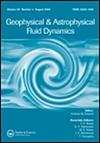可观测到的太阳活动光谱能否通过一个简单的发电机模型再现?
IF 1.1
4区 地球科学
Q3 ASTRONOMY & ASTROPHYSICS
Geophysical and Astrophysical Fluid Dynamics
Pub Date : 2023-10-20
DOI:10.1080/03091929.2023.2257372
引用次数: 0
摘要
摘要太阳活动的时间谱不仅仅是太阳的主周期。它包含不同的时间尺度,这些时间尺度可以看作是活动谱的连续分量。本文分析了基于E. Parker的原始思想的太阳活动简单模型的几个版本找到太阳磁活动变化谱的可能性。特别地,我们研究了具有两种抑制发电机作用的原始偏微分方程组和截断Parker方程得到的四阶动力系统。结果表明,模型中包含的非线性发电机抑制和动力混沌效应以及发电机驱动器的随机波动足以得到与观测相似的太阳主周期和光谱的连续分量。然而,所考虑的方法的能力因模型而异。每个模型在特定参数范围内再现光谱的连续分量。本研究证实了这样一种观点,即对各种太阳发电机模型进行检验,以寻找太阳活动主周期和太阳活动连续谱的合理组合,可以作为对其有效性的额外检验。关键词:太阳周期发电机模型太阳活动谱披露声明作者未报告潜在利益冲突。我们非常感谢那位让我们注意到这个重要问题的匿名推荐人。本研究在俄罗斯科学院项目AAAA-A19-119012290101-5的框架内进行。DS感谢BASIS基金会在21-1-1-4-1拨款项下的支持。本文章由计算机程序翻译,如有差异,请以英文原文为准。
Can the observable solar activity spectrum be reproduced by a simple dynamo model?
AbstractThe temporal spectrum of the solar activity is more than just the main cycle. It contains different timescales, which can be considered as continuous components of the activity spectrum. The possibility of finding a realistic spectrum of the solar magnetic activity variation is analysed for several versions of a simple model for solar activity based on the original idea of E. Parker. In particular, we study the original set of partial differential equations with two versions of suppression of the dynamo action and the fourth-order dynamical system obtained by truncating the Parker equations. We show that the effects included in the models, i.e. the nonlinear dynamo suppression and the dynamical chaos, as well as random fluctuations of the dynamo drivers, are quite sufficient to obtain the main solar cycle and the continuous components of the spectrum similar to the observed ones. However, the capabilities of the approach under consideration substantially vary from one model to another. Each model reproduces a continuous component of the spectrum in a specific parameter range. This study has confirmed the view that the examination of various solar dynamo models with the aim to find a reasonable combination of main activity cycle and continuous spectrum of solar activity can be used as an additional test of their validity.Keywords: Solar cycledynamo modelssolar activity spectrum Disclosure statementNo potential conflict of interest was reported by the author(s).Notes1 We are grateful to the anonymous referee who attracted our attention to this important problem.Additional informationFundingThis study has been performed within the framework of the Russian Academy of Sciences project AAAA-A19-119012290101-5. DS is grateful for support of the BASIS foundation under grant 21-1-1-4-1.
求助全文
通过发布文献求助,成功后即可免费获取论文全文。
去求助
来源期刊

Geophysical and Astrophysical Fluid Dynamics
地学天文-地球化学与地球物理
CiteScore
3.10
自引率
0.00%
发文量
14
审稿时长
>12 weeks
期刊介绍:
Geophysical and Astrophysical Fluid Dynamics exists for the publication of original research papers and short communications, occasional survey articles and conference reports on the fluid mechanics of the earth and planets, including oceans, atmospheres and interiors, and the fluid mechanics of the sun, stars and other astrophysical objects.
In addition, their magnetohydrodynamic behaviours are investigated. Experimental, theoretical and numerical studies of rotating, stratified and convecting fluids of general interest to geophysicists and astrophysicists appear. Properly interpreted observational results are also published.
 求助内容:
求助内容: 应助结果提醒方式:
应助结果提醒方式:


